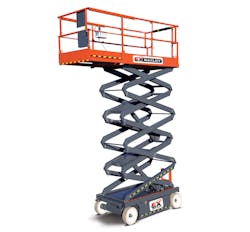Going Up with Bailey Cranes
Bailey Specialty Cranes & Aerials’s EX series of Boom Lifts and Scissor Lifts get an aircraft maintenance professional off the ground and up to where they need to go.
“We initially started as Man & Material Lift Engineering in 2000. We developed the EX series of Boom lifts and scissor lifts which was the standard for aircraft painting for all aircraft manufacturers in the US and Canada. We sold the business in 2010 and started up again in 2012 under Bailey Specialty Cranes & Aerials. The original need came from Gulfstream, L3 and Boeing. They did not have a strong source in the U.S. and we were manllift experts and the EX certification was well within our engineering expertise,” described Jeffrey Bailey, President of Bailey Cranes.
The main standard that covers the requirements for the EX lifts is NFPA 505, the Fire Safety Standard for Industrial trucks. The other standard that identifies detail requirements is ANSI/UL 583, Electric-Battery-Powered Industrial Trucks, which identifies the requirements for “E, “EE” and “EX.” “E” covers basic spark and shock protection, of which most general purpose lifts comply with this, said Bailey. The “EE” standard has increased spark and shock protection – approved in hazardous locations rated as Class I, Division 2, Group D – locations where explosive gases are typically present only when an accident occurs. “EX” has significantly enhanced spark protection and is approved in locations where gasses are typically present all the time and the hazardous location is identified as Class I Division 1, Group D. Paint overspray, for example, is an explosive gas and is part of the normal process.
Bailey said that they initially produced the entire lift but now have developed relationships with JLG and Skyjack to provide the base machines.
“Our customers already had their base machines and it made the training process easier,” added Bailey.
“The main differences between the original lifts and what we produce today is the use of intrinsically safe controls. Originally all the controls were hydraulic. This meant that 13 hoses went up the boom to the platform for hydraulic actuation. This meant big cable tracks, more hydraulic fittings and more leak-points. This is now replaced with standard electric joysticks but powered with Intrinsically safe power supplies that will not cause a spark. These are certified for use by Underwriters Labs. The other significant change this year is compliance with NFPA 70, The National Electrical Code where extra hard usage cable is no longer approved,” he continued.
